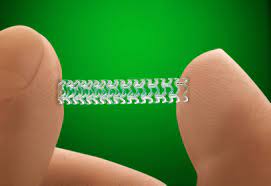 A bioresorbable stent can be inserted into a blood vessel or other internal duct to expand it to prevent or alleviate a blockage.
A bioresorbable stent can be inserted into a blood vessel or other internal duct to expand it to prevent or alleviate a blockage.
It is called a bioresorbable scaffold, biodegradable stent or naturally-dissolving stent.
Like metal stents, placement of a bioresorbable stent will restore blood flow and support the vessel through the healing process.
Bioresorbable stents, gradually resorb and can be benignly cleared from the body, enabling a natural reconstruction of the arterial wall and restoration of vascular function.
The most critical period of vessel healing is largely complete by approximately three to nine months, and the goal of a bioresorbable or temporary stenting is to fully support the vessel during this critical period, and then resorb from the body when it is no longer needed.
Bioabsorbable scaffolds include base materials that are either metals or polymers, and metallic magnesium-based scaffolds.
Metal stent candidates are iron, magnesium, zinc and their alloys.
Magnesium-based scaffolds have been implanted and a option in delivering against the drawbacks of permanent stents.
It degrades harmlessly, with functional degradation time of about 30 days in vivo, short of the three-to-six month window desired for bioabsorbable stents.
Recently, zinc was shown to exhibit outstanding physiological corrosion behavior, and is being evaluated.
Polymer-based stents are able to maintain a radially strong scaffold that breaks down over time into lactic acid, a naturally occurring molecule that the body can use for metabolism.
Resorbable scaffolds, or naturally dissolving stents, offer comparable efficacy and safety profile to drug-eluting stents.
The Magmaris resorbable magnesium scaffold has a favorable safety profile with low target lesion failure and scaffold thrombosis rates.
The Absorb naturally dissolving stent is also been investigated: the naturally dissolving stent begins to dissolve from six to 12 months and is fully dissolved between two and three years after it is placed in the artery.
The artery is able to dilate and contract, called vasomotion, similar to a healthy blood vessel at two years.
